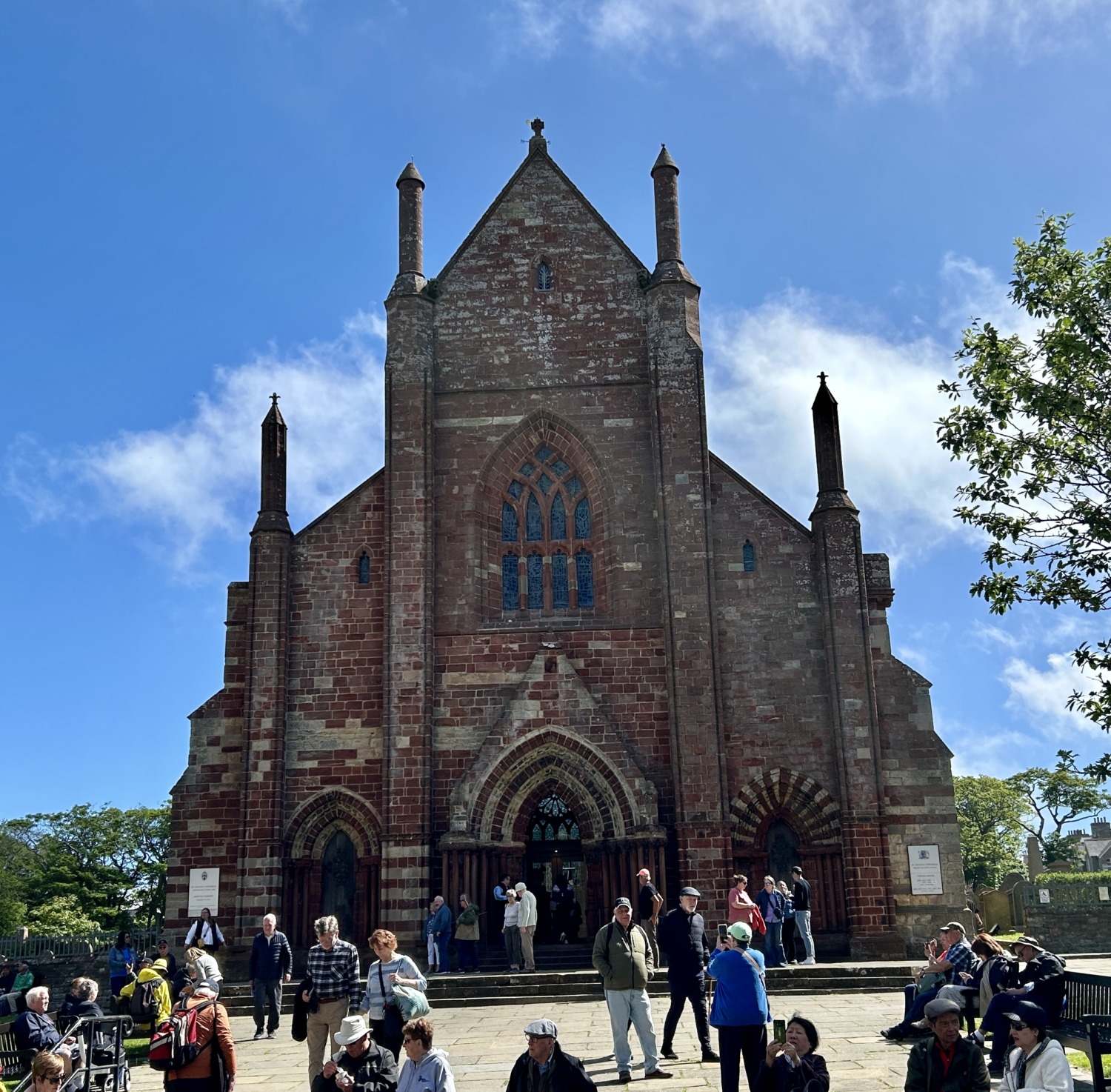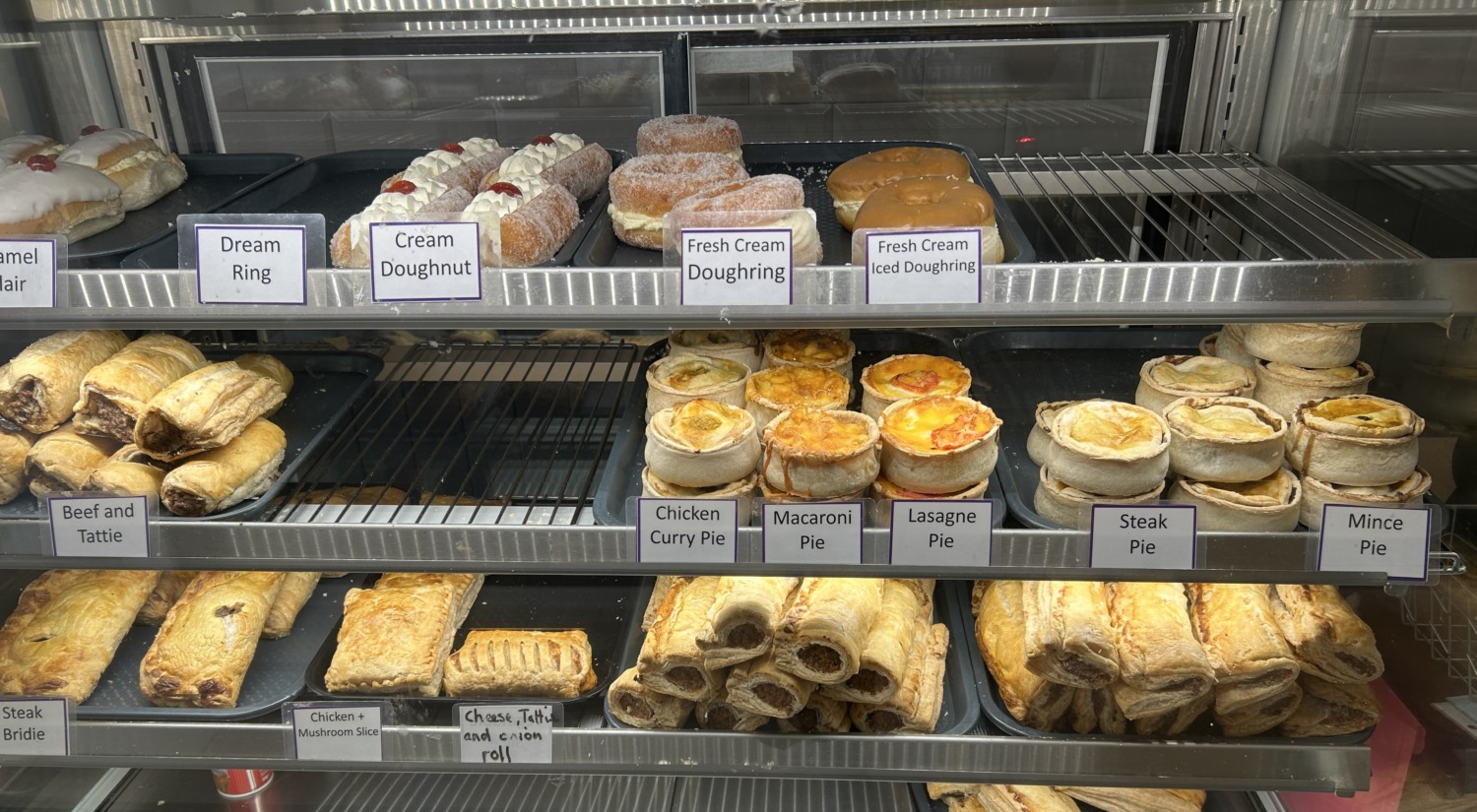The day after visiting Lerwick, our ship arrived in Kirkwall. Kirkwall is located on the island of Mainland. Mainland is one of 70 islands in the Orkney Archipelago. Twenty of the islands are inhabited and Mainland is the largest, while Kirkwall is the biggest town. Orkney is one of the councils of Scotland, part of the United Kingdom. Kirkwall was founded before 1046 and has a population of about 10,000 people.
Our ship was anchored in the harbor, so Tom and I rode the tender in to the Kirkwall city center. We were greeted by some volunteers who handed out maps and answered questions. The map wasn’t very detailed, but it included all the places that a tourist would want to visit. Cunard’s Queen Anne was docked at the one deep water berth, so the town was crowded with cruise passengers.

Tom and I started out with a walk around the Peedie Sea. The Peedie Sea (small sea) is the remnant of what used to be a much larger, marshy loch which occupied much of the flat basin on which western Kirkwall is now built. As the town expanded, competition for land grew, leading to the construction of an “ayre” or spit blocking off the marshy area from the ocean. Most of the newly landlocked lake was then reclaimed, leaving a largish pond now inhabited by ducks, swans, and gulls. Again, we lucked out with the weather and enjoyed the perfect temperature with sunny skies.

Once we circumnavigated Peedie Sea, we headed to the Orkney Wireless Museum. This is a small museum that houses a collection of radios, wireless sets, and other electronic items of interest. Most of the collection came from museum founder, James MacDonald. There is a little bit of everything and lots of odds and ends. I asked the volunteer there what was his favorite thing in the museum, and he said the radar display. He explained how important radar was in the defense of Great Britain during World War II. To me, his explanation was the most interesting thing in the museum.
After enjoying the museum, Tom and I headed to the center of town. We found Albert Street, which seemed to have most of the shops and restaurants. Unlike Lerwick, Kirkwall had plenty of souvenir shops. There were also lots of beautiful Orkney-made goods. Tom and I checked out the shops, noting several to revisit for later. I found a demitasse spoon and scooped it up.

Next on the list was the St. Magnus Cathedral. St. Magnus Cathedral was founded in 1137 by the Viking, Earl Rognvald, in honor of his uncle St. Magnus. St. Magnus, Earl of Orkney, was killed by a rival. After his death, many miracles were attributed to him. The bones of both Magnus and Rognvald lie in the walls of the choir. After the Scottish Reformation in 1560, the cathedral was used for Protestant worship and John Knox was the pastor.
Restoration work took place in the 1850’s and in the 1920’s. The present floors, woodwork, stained glass windows, and spire were installed during these renovations. The church is made out of sandstone and you can see the weathering on some of the pillars outside the church. Gravestones line the walls and there are beautiful carvings from the 13th century.

After marveling at the beauty of the cathedral, we headed next door to the ruins of the Earl’s Palace and the Bishop’s Palace. Then we went to the Orkney Museum. The Orkney Museum did a nice job of telling the chronology of the history of the Orkney Islands, especially the excavation of the Ness of Brodgar. The Ness is a massive complex of Neolithic buildings from 3,000 BCE. The museum started with the Ness, and worked its way through Norse, Viking, and Scottish history in the Orkneys. There is still an Earl of Orkney (earldom established in 872) but he doesn’t have any influence in saying how things are run. The current Earl, Peter St. John, lives in Canada.
Having exhausted our desire to see churches or museums, all before noon, Tom and I headed to a bakery for some lunch. We had noticed the place earlier and saw that they had beef and tattie, which looked delicious. We each got a warm roll and ate it on a bench in front of the cathedral. Then we returned to a couple of shops.
We ended our day in Kirkwall by enjoying a walk along the harbor. As I said, the temperature was perfect and the day was sunny and beautiful. We watched the ferries and tenders move around the harbor and watched the sea birds fly overhead. We enjoyed our day in Kirkwall very much.




